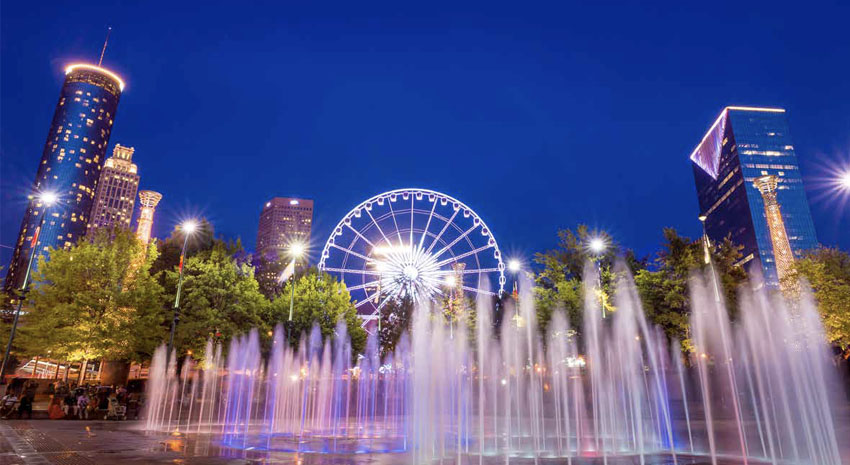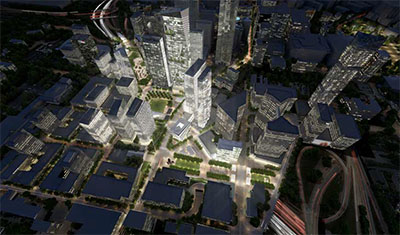October 2017, United States

Photo: © F11PHOTO | DREAMSTIME
“ATLANTA IS THE BEST IN THE U.S. … a renowned business climate with an unrivaled quality of living.” City advocates don’t bother to equivocate, and numerous accolades back up their claims: ranked the No. 1 business state in the United States; listed among Lonely Planet’s Top 10 Places to Travel; cited by Travel + Leisure among America’s “most charming,” “friendliest” and “most cultured” cities. Technically a vast region of 8,376 square miles encompassing 29 counties and 242 neighborhoods, metropolitan Atlanta is an alpha world city with a $270 billion gross domestic product and rated eighth in America for its impact on commerce, research finance, technology, media, art and entertainment.
More Fortune 500 companies operate in the city’s business-friendly environment than in Dallas and Nashville combined. Delta Air Lines, Home Depot, ATT, UPS, Marriott and Publix are among the top 10 regional employers. Within the last two years, Honeywell, Adidas, NCR and GE installed major new operations in the area, creating thousands of jobs. One of the fastest-growing hightech urban centers in the nation, Atlanta leads innovation and industry growth, becoming a world-class hub for tech design, implementation and innovation.
Supporting business interaction is the convenient Hartsfield-Jackson Atlanta International Airport, serving 110 million passengers annually and “connecting more people than any other airport in the world,” with 80 percent of the U.S. population within a two-hour flight.
Priding itself on “a collaborative hospitality community that is dedicated to making every meeting a success,” the Atlanta Convention and Visitors Bureau teams with local vendors of the city’s $15 billion hospitality industry to create a seamless experience for 51 million annual visitors to the Georgia World Congress Center. Already the nation’s fourth-largest convention facility, it is currently expanding to equal a million square feet of contiguous meeting space in walkable Downtown among thriving music venues and restaurants.

THE STITCH © JACOBS
While much of America lags, with no long-range plans to tackle decaying infrastructure and decline, Atlanta teems with vivacity and vision. Burned to the ground by Gen. Sherman’s forces, the city emerged from the Civil War aware that cooperation was necessary for recovery, and that legacy remains with Chamber of Commerce official Gregg Simon noting “the state and city work hand in glove with the Chamber and business for the good of the area.”
Jump-started by construction projects to improve parks, sporting venues and transit structure for the 1996 Olympic Games, the city transformed its Atlantic Station section and the defunct Atlantic Steel Mill into vibrant residential and entertainment urban hubs. Subsequent master plans and projects include the $2.8 billion Atlanta BeltLine, reversing bad planning by circling the city with a 22-mile network of parks, trails and transit to connect and spur development in 45 neighborhoods. A pending project, the $300 million “Stitch,” proposes covering a section of the Interstate with concrete decking to override the no-man’s-land of parking lots and traffic lanes which divides Downtown and Midtown, creating 14 new acres for hotels, restaurants and green space.
Fostering development, Chamber of Commerce programs attract new firms, assist young companies and help identify businessto- business collaborations. To expand the workforce, millennials are steered to a dedicated website, ChooseATL, that lists job openings and cultural and network events promising young professionals the opportunity to “find your perfect neighborhood … your dream job, your tribe, and a sense of community unlike any other … a place where careers and culture collide.” While studies indicate the challenges the city presents to those rising from poverty, interns and graduates of the 70 local colleges are cultivated to stay on among the 75,000 new residents added to the 6.5 million population each year.
SCENIC DRIVES
Two nearby excursions take you on jaunts north to the Atlanta Braves’ new SunTrust Stadium and south to the headquarters of Porsche. Whether or not the Braves are playing, the stadium includes a whole complex of shops and cafés and the nearby indoor skydiving wind tunnel of iFLY Atlanta. Near the airport at the sports car firm’s headquarters, the Porsche Driving Experience invites visitors to take a turn behind the wheel.
Farther afield, a drive on the 60-mile-long Alleghany Foothills Parkway skirts the southern edge of the Appalachians, passing the spectacular scenery and wildlife of Chattahoochee National Forest; the Southeast’s tallest cascade, Amicalola Falls; and Georgia’s highest summit, Brasstown Bald.
Almost inevitable — fiddledeedee! — is a tour through the Gone with the Wind Trail. Augmenting the City Library’s extensive collection of memorabilia illuminating the story that won an Academy Award and Pulitzer Prize, a drive takes aficionados to two museums chronicling the thrilling romance of Scarlett O’Hara and Rhett Butler. Marietta’s Gone with the Wind Museum: Scarlett on the Square and Jonesboro’s Road to Tara Museum exhibit costumes, scripts and clippings. The route passes the historic antebellum Stately Oaks Plantation and Kennesaw Mountain National Battlefield Park, where the Confederate Army briefly thwarted Gen. Sherman’s March to the Sea.
